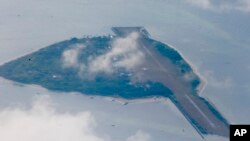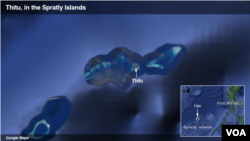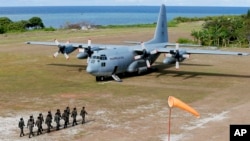Philippine officials say they may put hotels on an island that the country claims in the disputed South China Sea. Experts say the move could be an effort to boost the Philippines’ territorial claim over Thitu island and to counter Chinese expansion in the sea.
Philippine Defense Secretary Delfin Lorenzana recently spoke about planned improvements for Thitu. He said the main goal is to repair a runway on the island by the end of the year.
But Lorenzana said there were also plans to build military structures on Thitu for troops and “maybe some hotels for Filipinos who would like to go there as tourists.”
Such plans would make Thitu one of only a small number of landforms in the South China Sea with tourism activists. The 37-hectare island is currently home to about 100 people.
China claims most of the South China Sea, an important waterway through which trillions of dollars in trade pass each year. The area contains rich fishing waters and is believed to hold oil and natural gas. The Philippines, Taiwan, Vietnam, Brunei and Malaysia all claim ownership to parts of the sea.
Several other claimants have criticized China for using undersea landforms in the South China Sea to build artificial islands. China has placed military structures and equipment on some of the islands.
Alan Chong is a professor at the S. Rajaratnam School of International Studies in Singapore. He told VOA that tourism can serve as “a form of virtual occupation” of an island. Chong said this can help a country show that there is “legitimization of civilian activity” in disputed territories.
Thitu is one of nine Philippine-controlled landforms in the larger, heavily disputed Spratly islands group.
In April, as many as 200 Chinese boats surrounded Thitu, which raised concerns in the Philippines. The boats later headed back out to sea. In 2012, China took control from the Philippines another group of disputed islands, called Scarborough Shoal.
Fabrizio Bozzato is an expert on Asia and the Pacific at the Taiwan Strategy Research Association. He told VOA that tourism can help establish an island’s "actual use" to support territorial claims.
Bozzato said he thinks the Philippines’ efforts to improve Thitu are an attempt to demonstrate “actual control and use” of the island. He added that such action on Thitu could also support Philippine territorial claims over other islands the country controls.
Malaysia, China and Vietnam already permit tourism in disputed areas of the sea. Malaysia first began letting tourists visit a diving area on a Spratly holding called Layang Layang in the 1980s.
Vietnam offers South China Sea tours to its own citizens.
And China is developing tourism around Sansha, a 1,000-person city it built in the sea's Paracel Islands. A Chinese tourist company says a ship named Princess Coconut is planning to take visitors from the Chinese mainland to Sansha for two-day trips.
I’m Jonathan Evans.
Bryan Lynn wrote this story for VOA Learning English, based on reports from VOA News and Reuters. Ashley Thompson was the editor.
We want to hear from you. Write to us in the Comments section, and visit our Facebook page.
________________________________________________________________
Words in This Story
runway – n. large road that aircraft use to land on or to start flying from
tourist – n. someone who visits a place for fun and does not live there
artificial – adj. something not natural but created by people
virtual – adj. almost or nearly as described, but not existing physically
legitimize– v. to follow according to official rules or laws











